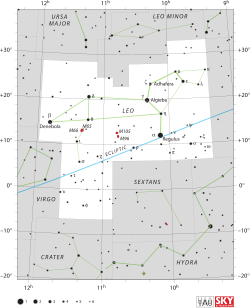Gliese 408
| Gliese 408 | |
 | |
| Observationsdata Epok: J2000.0 | |
|---|---|
| Stjärnbild | Lejonet |
| Rektascension | 10t 00m 04,25686 s[1] |
| Deklination | +22° 49′ 58,6491 ″[1] |
| Skenbar magnitud () | +10,020[2] |
| Stjärntyp | |
| Spektraltyp | M2.5 V[3] |
| U–B | +1,22[4] |
| B–V | +1,55[4] |
| Astrometri | |
| Radialhastighet () | +3,15[5] km/s |
| Egenrörelse (µ) | RA: -427,01[1] mas/år Dek.: -281,82[1] mas/år |
| Parallax () | 148,1986 ± 0,0253[6] |
| Avstånd | 22,008 ± 0,004 lå (6,748 ± 0,001 pc) |
| Absolut magnitud () | +10,82[4] |
| Detaljer | |
| Massa | 0,406 ± 0,007[7] M☉ |
| Radie | 0,43[8] R☉ |
| Luminositet | 0,0037[9] L☉ |
| Temperatur | 3 530[3] K |
| Metallicitet | -0,14[7] |
| Vinkelhastighet | <2,3[7] km/s |
| Andra beteckningar | |
| LHS 6193, AP J11000432+2249592, G 58-32, G 120-9, G 119-49, GJ 408, HIC 53767, HIP 53767, LSPM J1100+2249, 2MASS J11000432+2249592, NLTT 25946, PLX 2561, TYC 1978-1286-1, UCAC2 39850706, UCAC4 565-047644, USNO-B1.0 1128-00230478, WISEA J110003.93+224955.7, Gaia DR2 3988987164339438208, Gaia DR3 3988987164339438208[10] | |
Gliese 408 är en ensam stjärna i mellersta delen av stjärnbilden Lejonet. Den har en skenbar magnitud av ca 10,02[2] och kräver åtminstone ett mindre teleskop för att kunna observeras. Baserat på parallaxmätning inom Hipparcosuppdraget enligt Gaia Data Release 2 på ca 148,2 mas,[6] beräknas den befinna sig på ett avstånd på ca 22 ljusår (ca 6,7 parsek) från solen. Den rör sig bort från solen med en heliocentrisk radialhastighet på 3 km/s.[5]
Egenskaper[redigera | redigera wikitext]
Gliese 408 är en röd dvärgstjärna i huvudserien av spektralklass M2.5 V.[3] Den har en massa som är ca 0,41[7] solmassa, en radie som är ca 0,43[8] solradie och har ca 0,0037[9] gånger solens utstrålning av energi från dess fotosfär vid en effektiv temperatur av ca 3 500 K.[3] Inga tecken på en omgivande stoftskiva kring stjärnan har observerats.[11]
Referenser[redigera | redigera wikitext]
- Den här artikeln är helt eller delvis baserad på material från engelskspråkiga Wikipedia, Gliese 408, 14 november 2022.
Noter[redigera | redigera wikitext]
- ^ [a b c d] van Leeuwen, F.; et al. (2007). "Validation of the new Hipparcos reduction". Astronomy and Astrophysics. 474 (2): 653–664. arXiv:0708.1752. Bibcode:2007A&A...474..653V. doi:10.1051/0004-6361:20078357. S2CID 18759600.
- ^ [a b] "GJ 408". SIMBAD. Centre de données astronomiques de Strasbourg.
- ^ [a b c d] Lépine, Sébastien; et al. (2013). "A Spectroscopic Catalog of the Brightest (J < 9) M Dwarfs in the Northern Sky". The Astronomical Journal. 145 (4): 102. arXiv:1206.5991. Bibcode:2013AJ....145..102L. doi:10.1088/0004-6256/145/4/102. S2CID 117144290.
- ^ [a b c] "ARICNS 4C00834". ARICNS. Hämtad 23 januari 2017.
- ^ [a b] Nidever, David L.; et al. (2013). "Radial Velocities for 889 Late-Type Stars". The Astrophysical Journal Supplement Series. 141 (2): 503–522. arXiv:astro-ph/0112477. Bibcode:2002ApJS..141..503N. doi:10.1086/340570. S2CID 51814894.
- ^ [a b] Brown, A. G. A.; et al. (Gaia collaboration) (2021). "Gaia Early Data Release 3: Summary of the contents and survey properties". Astronomy & Astrophysics. 649: A1. arXiv:2012.01533. Bibcode:2021A&A...649A...1G. doi:10.1051/0004-6361/202039657. S2CID 227254300. (Erratum: doi:10.1051/0004-6361/202039657e). Gaia EDR3 record for this source at VizieR.
- ^ [a b c d] Jenkins, J. S.; Ramsey, L. W.; Jones, H. R. A.; Pavlenko, Y.; Gallardo, J.; Barnes, J. R.; Pinfield, D. J. (2009). "Rotational Velocities for M Dwarfs". The Astrophysical Journal. 704 (2): 975–988. arXiv:0908.4092. Bibcode:2009ApJ...704..975J. doi:10.1088/0004-637X/704/2/975. S2CID 119203469.
- ^ [a b] Pasinetti Fracassini, L. E.; et al. (2001). "Catalogue of Apparent Diameters and Absolute Radii of Stars (CADARS) - Third edition - Comments and statistics". Astronomy & Astrophysics. 367 (2): 521–24. arXiv:astro-ph/0012289. Bibcode:2001A&A...367..521P. doi:10.1051/0004-6361:20000451. S2CID 425754.
- ^ [a b] "Catalogue Astrographique +23°468-46". The Internet Stellar Database.
- ^ GJ 408 (unistra.fr). Hämtad 2023-05-29.
- ^ Lestrade, J.-F.; Wyatt, M. C.; Bertoldi, F.; Dent, W. R. F.; Menten, K. M. (2006). "Search for cold debris disks around M-dwarfs". Astronomy and Astrophysics. 460 (3): 773–741. arXiv:astro-ph/0609574. Bibcode:2006A&A...460..733L. doi:10.1051/0004-6361:20065873. S2CID 119328045.





